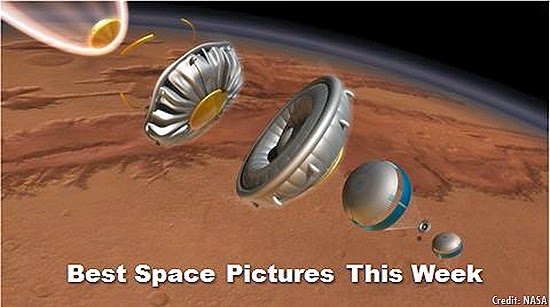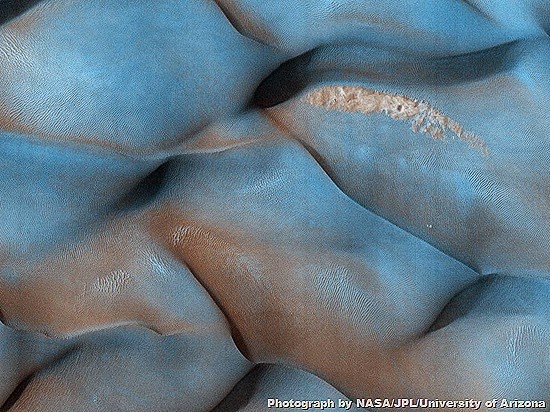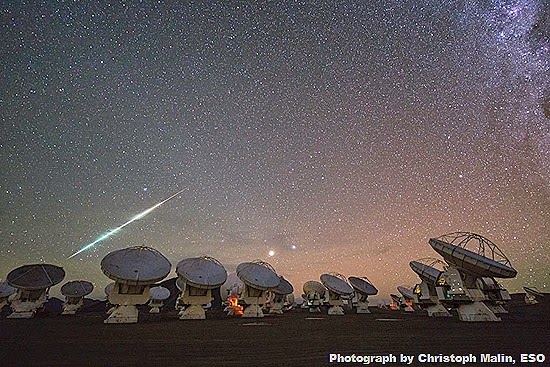
Best Space Pictures of the Week: Flying Saucer, Mars's "Heart"
By Dan Vergano, National Geographic News, 11 April 2014.
By Dan Vergano, National Geographic News, 11 April 2014.
NASA reveals a flying saucer, a heart is spotted on Mars, and the Milky Way gleams in this week's best space pictures.
1. NASA’s Flying Saucer
Aliens haven't landed - the flying saucer seen in this April 9 picture belongs to NASA, not invaders from Mars.
In fact, the saucer is planned for an earthly invasion of Mars. The rocket-powered test vehicle belongs to the space agency's Low-Density Supersonic Decelerator (LDSD) project, an effort to test better supersonic parachutes and high-altitude landing brakes for future Mars explorers.
On display this week at NASA's Jet Propulsion Lab, the device will be fired from Hawaii this summer, almost into space, to undertake a series of tests aimed at safely delivering heavier cargoes, and astronauts, to the red planet someday.
2. Dust Glints on Martian Dunes
High-flying winds on Mars lead to twin-toned dunes, seen in this Mars Reconnaissance Orbiter image released on April 9.
The HiRISE camera aboard the orbiter sees into the infrared spectrum, revealing the dual colouring of the dunes located in the Meridiani Terra region of Mars.
Rusty, light-coloured dust coats the lower-lying folds of the dunes. That's because they are left unmolested by fierce winds that flow at higher altitudes. (See "Pictures: Looking Back at Visions of Life on Mars.")
Higher up on the dunes, the winds scour their surfaces, removing the dust and revealing the dark blue sands underlying the dune crests.
3. Fireball Flares Above Watchful Eyes
High above the Chilean Andes, a fireball zooms past the high-precision antennas of a desert space observatory, as seen in this April 7 time-lapse picture released by the European Southern Observatory.
The shooting star is just a bit of space dust burning up as it zips through the upper atmosphere, leaving a fiery wake. (See "Star Found Shooting Water 'Bullets.'")
Beneath the meteor, some of the 66 antennas of the Atacama Large Millimetre/submillimetre Array (ALMA) observatory keep an eye on far more distant space phenomena from their perch some 16,404 feet (5,000 meters) above sea level.
Just above the antennas, in the centre of the image, Mars and the star Spica, the brightest star in the constellation Virgo, burn brightly in the night sky.
4. Ancient Mars Vent Dusted Over
Just outside an ancient volcano, this curious heart-shaped feature rears above the Martian plain, as seen in an April 9 view by NASA's HiRISE camera.
Most likely, the ridges enfolding the mount reveal that it's a long-dormant, dusted-over volcanic vent. Winds eroded the softer rocks surrounding the vent ridges, leaving only fortress-like walls behind. (See "Strange Lights in Mars Photos Are Not Alien Bonfires.")
Such "inverted terrains" are a hallmark of Mars, its surface sculpted by hundreds of millions of years of dusty winds blowing over volcanic rock.
5. Milky Way Meets Desert Sky
Photograph by Babak Tafreshi, TWAN
Our Milky Way galaxy gleams in all its splendour, as seen from a desert observatory in a recent picture released by the astronomy-education project The World At Night (TWAN).
The clear, dry desert air provides a perfect home for the La Silla Observatory, where the 11.8-foot (3.6-meter) New Technology Telescope (NTT) makes its nightly rounds of the sky's far reaches. The telescope rests between the open doors in the photo.
The Milky Way spans more than 100,000 light-years across, putting Earth in the cosmic suburbs, some 27,000 light-years away from the brightly glowing centre of the galaxy, seen at the centre of this image.
Top image: NASA's Low Density Supersonic Decelerator prototype. Credit: NASA.





No comments:
Post a Comment
Please adhere to proper blog etiquette when posting your comments. This blog owner will exercise his absolution discretion in allowing or rejecting any comments that are deemed seditious, defamatory, libelous, racist, vulgar, insulting, and other remarks that exhibit similar characteristics. If you insist on using anonymous comments, please write your name or other IDs at the end of your message.